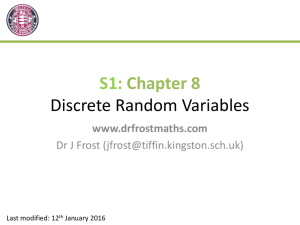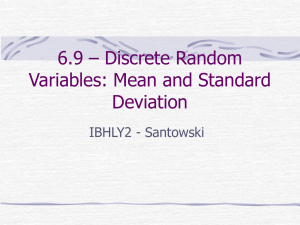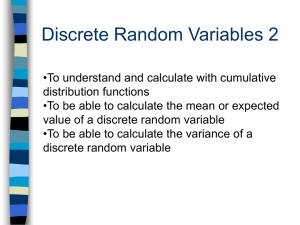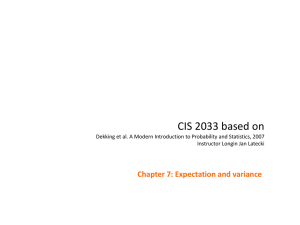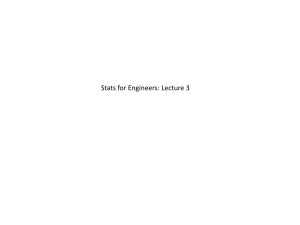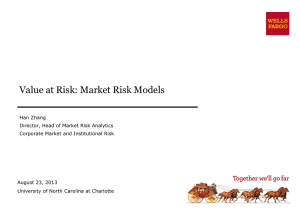S1 - Chapter 8 - Discrete Random Variables
advertisement
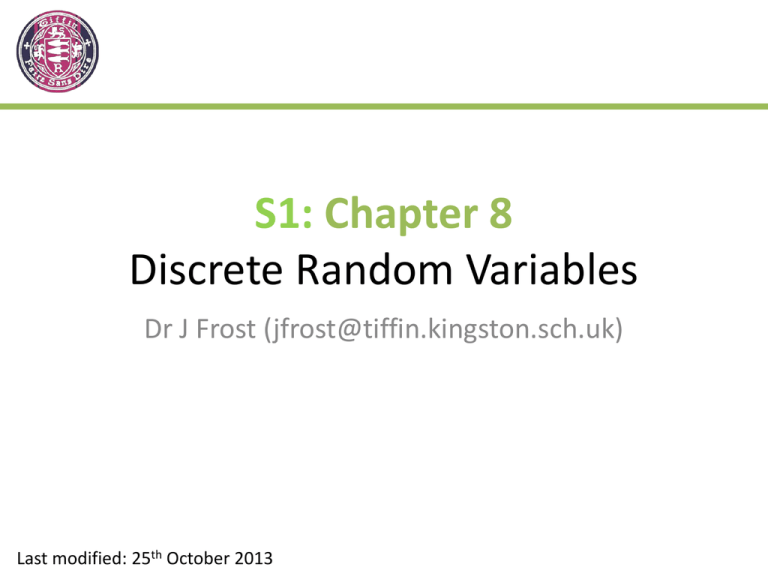
S1: Chapter 8
Discrete Random Variables
Dr J Frost (jfrost@tiffin.kingston.sch.uk)
Last modified: 25th October 2013
Variables and Random Variables
In Chapter 2, we saw that just like in algebra, we can use a variable
to represent some quantity, such as height.
A random variable 𝑿 represents a single experiment/trial, and
has 2 ingredients:
1. THE OUTCOMES /SUPPORT VECTOR
We tend to use a lowercase variable letter to represent
the value of the outcome.
A random variable representing
the throw of an unfair die:
x
1
2
3
4
5
6
P(X=x)
0.3
0.2
0.1
0.25
0.05
0.1
2. PROBABILITY FUNCTION
e.g. P(X = 3) = 0.1. It is just a function that maps an outcome to the probability.
The probability function for a discrete variable has two obvious constraints:
(a) The outputs have to be between 0 and 1, i.e. 0 ≤ 𝑃 𝑋 = 𝑥 ≤ 1.
(b) The sum of the outputs is 1, i.e. Σ𝑃 ?𝑋 = 𝑥 = 1
Is it a discrete random variable?
The height of a person
randomly chosen.
The number of cars that
pass in the next hour.
The number of countries in
the world.
No
Yes
This is a continuous random variable.
No
Yes
No
Yes
It does not vary, so is not a variable!
Notation and Terminology
The are two equivalent ways of writing a probability:
Full notation:
𝑃(𝑋 = 𝑥)
e.g. P(C = blue)
This says “the probability the
outcome of an experiment,
represented by the random
variable 𝑋, is the value 𝑥.
Shorthand:
𝑝(𝑥)
e.g. p(blue)
Note the lowercase 𝑝
instead of uppercase.
Because a probability function is ultimately just a function, on the rare occasion
it’s written as 𝑓(𝑥), where x is a particular outcome. Don’t be upset by this.
Example
The random variable 𝑋 represents the number of heads when
three coins are tossed.
Underlying
Sample Space
{ HHH,
HHT,
HTT,
HTH,
THH, ?
THT,
TTH,
TTT }
Probability Function
Num heads x
0
1
2
3
P(X=x)
1/8
3/8
3/8
1/8
?
The second way of writing it allows us to conflate outcomes
with the same probability. In the Edexcel syllabus, we call
the table a probability distribution and the latter form a
probability function. The true distinction is slightly
abstract/subtle: don’t worry about it for now!
Exam Question
Edexcel S1 May 2012
(Hint: Use your knowledge
that Σ𝑝
= 1)
p(-1) = 4k, p(0) = k, p(1) = 0, p(2) = k
And since Σ𝑝 𝑥 = 1, 4k + k + 0 + k = 6k = 1
?
1
Therefore 𝑘 =
6
Exercise 8A
5
The random variable X has a probability function
P(X = x) = kx, x = 1, 2, 3, 4.
1
Show that 𝑘 =
10
7
The random variable X has a probability function:
where k is a constant.
a) Find the value of k.
b) Construct a table giving the probability distribution of X.
7a) k = 0.125
7b)
?
x
1
2
P(X = x)
0.125
0.125
3
4
0.375
0.375
Probabilities of ranges of values
x
1
P(X=x) 0.1
2
0.2
3
0.3
4
0.25
?
𝑃 1 < 𝑋 < 5 = 0.75
?
𝑃 2 ≤ 𝑋 ≤ 4 = 0.75
𝑃 3 < 𝑋 ≤ 6 = 0.4?
𝑃 𝑋 ≤ 3 = 0.6 ?
5
0.1
6
0.05
Cumulative Distribution Function (CDF)
How could we express “the
probability that the age of someone
is at most 40”?
? 40
𝑃 𝐴≤
𝐹 40?
F is known as the cumulative
distribution function, where
𝐹 𝑥 =𝑃 𝑋≤𝑥
(note the capital F)
If X is the number of heads
thrown in 2 throws...
x
0
P(X=x) 0.25
?
1
0.5?
2
0.25
?
x
F(x)
1
0.75
?
2
1 ?
0
0.25
?
Example
The discrete random variable X has a cumulative distribution function
𝐹(𝑥) defined by:
𝐹 𝑥 =
a
𝑥+𝑘
;
8
x = 1, 2 and 3
Find the value of k.
F(3) = 1. Thus
? k = 5.
b Draw the distribution table for the cumulative distribution function.
x
F(x)
c
1
3/4?
2
7/8?
3
1 ?
Write down F(2.6)
F(2.6) = F(2)
? = 7/8
d Find the probability distribution of X.
x
1
P(X=x) 3/4?
2
3
1/8?
1/8?
CDF
F(x)
p(x)
1
Shoe Size (x)
?
Shoe Size (x)
It’s just like how we’d turn a frequency graph
into a cumulative frequency graph.
Exam Questions
Edexcel S1 May 2013 (Retracted)
= 0.4
?
x
1
2
P(X = x)
0.4
? 0.25
3
0.35
Edexcel S1 Jan 2013
F(3) = 1, so (27 +?k)/40 = 1, ...
x
1
P(X = x)
0.35
?
2
3
0.175
0.475
Expected Value, E[X]
Suppose that we throw a single fair die 60 times, and see the following outcomes:
x
1
2
3
4
5
6
Frequency
9
11
10
8
12
10
What is the mean outcome based on our sample?
𝑥 =?3.55
But using the actual probabilities of each outcome (i.e. 1/6 for each), what would
we expect the average outcome to be?
?
3.5
If X is the random variable, 𝑬[𝑿] is known as the expected value of 𝑋.
𝐸 𝑋 =Σ𝑥𝑝 𝑥
You could think of it as the weighted sum of the outcomes (where the weights are
the probabilities)
Quickfire E[X]
Find the expected value of the following distributions (in your head!).
x
1
2
3
x
4
6
8
P(X = x)
0.1
0.6
0.3
P(X = x)
0.5
0.25
0.25
E[X] = 2.2?
E[X] = 5.5?
x
10
20
30
P(X = x)
1/3
1/3
1/3
E[X] = 20 ?
Harder Example
x
1
2
3
4
5
P(X = x)
0.1
p
0.3
q
0.2
Given that E[X] = 3, find the values of p and q.
p + q + 0.1 + 0.3 + 0.2 = 1
(1 x 0.1) + (2 x q) + (3 x 0.3) + (4 x q) + (5 x 0.2) = 3
?
Thus q = 0.1, p = 0.3
To E[X2] and beyond
Remember with the mean for a sample, we could find the “mean of the squares”
when finding variance, e.g.
Σ𝑓𝑥 2
?
Σ𝑓
We just replaced each value 𝑥 with its square.
Unsurprisingly the same applies for the expected value of a random variable.
Just replace 𝑥 with whatever is in the square brackets. Sorted!
x
1
2
3
P(X = x)
0.1
0.5
0.4
E[X2] = (12 x 0.1) + (22 x 0.5) +? (32 x 0.4) = 5.7
E[2X] = (2 x 0.1) + (4 x 0.5) + ?(6 x 0.4) = 4.6
E[1 – X] = (0 x 0.1) + (-1 x 0.5) ?+ (-2 x 0.4) = -1.3
Variance
We know how to find it for experimental data. How about for a random variable?
Mean of the Squares
Minus
? 2]
Var[X] = E[X
Square of the Mean
? 2
E[X]
–?
x
1
2
3
P(X = x)
0.1
0.5
0.4
Var[X] = 5.7 – 2.3?2 = 0.41
(We already
worked out that
E[X2] = 5.7)
Exam Questions
Edexcel S1 May 2010
a = 1/4
?
=1?
E[X2] = 3.1
2 = 2.1
So Var[X]
=
3.1
–
1
?
Edexcel S1 Jan 2009
?= 1
= P(X <= 1.5) = ?
P(X <= 1) = 0.7
E[X2] = 2. So Var[X]
? = 2 – 12 = 1
Coding!
Oh dear god, not again...
Recap
Suppose that we have a list of peoples heights x. The mean height is 1.5m and
the variance 0.2m.
We use the coding 𝒚 = 𝟑𝒙 – 𝟏𝟎:
𝑦 = −5.5?
𝜎𝑦2 = 1.8 ?
It’s no different with expected values. What do we expect these to be in terms
of the original expected value E[X] and the original variance Var[X]?
E[X + 10] = E[X]?+ 10
E[3X] = 3E[X]
?
?
Var[3X] = 9Var[X]
Adding 10 to all values adds
10 to the expected value.
Quickfire Coding
Express these in terms of the original E[X] and Var[X].
? +1
E[4X + 1] = 4E[X]
?
E[1 – X] = 1 – E[X]
Var[4X] = 16Var[X]
?
Var[X + 1] = Var[X]
?
?
Var[3X + 2] = 9Var[X]
?
E[(X-1)/2] = (E[X]-1)/2
Var[(X-1)/2] = ¼ Var[X]
?
Exercise 8E
2 E[X] = 2, Var[X] = 6
Find
a) E[3X] = 3E[X]?= 6
d) E[4 – 2X] = 4 – 2E[X]
? =0
f) Var[3X + 1] = 9Var[X]
? = 54
5 The random variable Y has mean 2 and variance 9.
Find:
a) E[3Y+1] = 3E[Y] ?
+1=7
c) Var[3Y+1] = 9Var[Y]
? = 81
e) E[Y2] = Var[Y] + ?
E[Y]2 = 13
f) E[(Y-1)(Y+1)] = E[Y2 – 1] = E[Y
? 2] – 1 = 12
Discrete?Uniform distribution
If X is the throw of a fair die, this obviously is its distribution...
x
1
2
3
4
5
6
P(X = x)
1/6
1/6
1/6
1/6
1/6
1/6
We call this a discrete?uniform distribution.
If had say an n-sided fair die, then:
𝑛+1
𝐸𝑋 = ?
2
1
𝑉𝑎𝑟 𝑋 =
𝑛 + 1? 𝑛 − 1
12
You won’t have exam questions on these, but they’re useful to know.
Example
Digits are selected at random from a table of random numbers.
a) Find the mean and standard deviation of a single digit.
b) Find the probability that a particular digit lies within one standard deviation of the
mean.
a) Our digits are 0 to 9. We have useful formulae when the numbers start from 1 rather
than 0. If the digit is R, let X = R + 1
Then E[R] = E[X – 1] = E[X] – 1 = 11/2 – 1 = 4.5
Var[R] = Var[X – 1]
= Var[X]
1
= 12 10 + 1 10 − 1
= 8.25
So 𝜎 = 2.87 (to 2sf)
?
b) We want 𝑃 4.5 − 2.87 < 𝑅 < 4.5 + 2.87
= 𝑃 1.63 < 𝑅 < 7.37
=𝑃 2≤𝑅≤7
?
6
=
10
